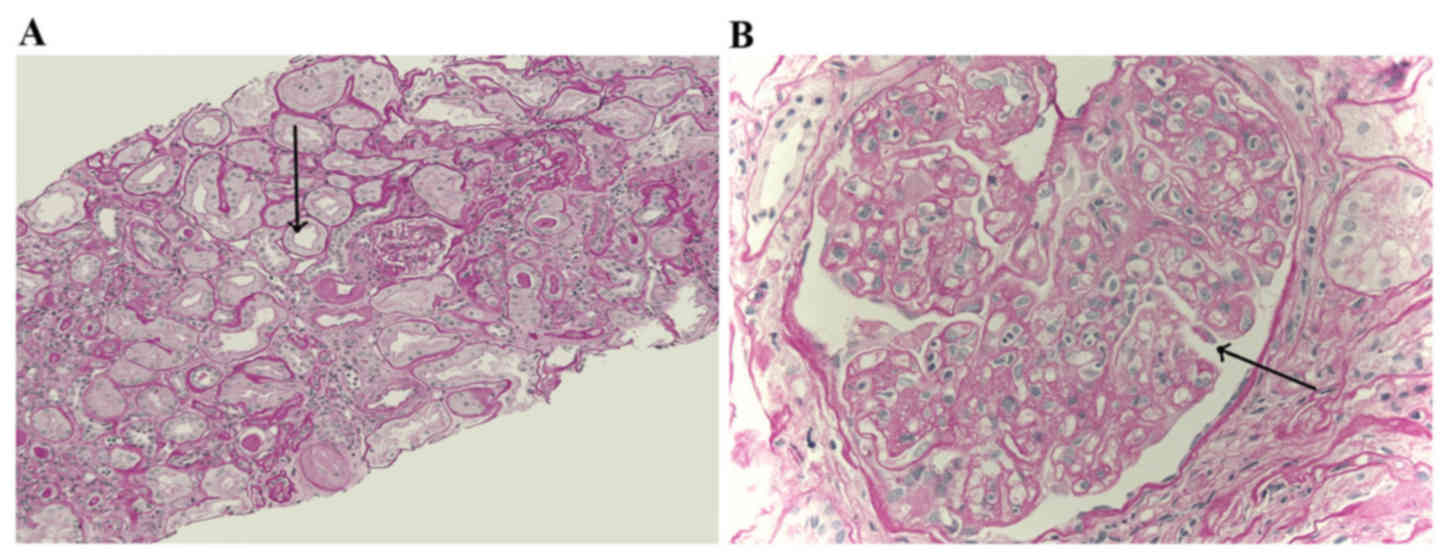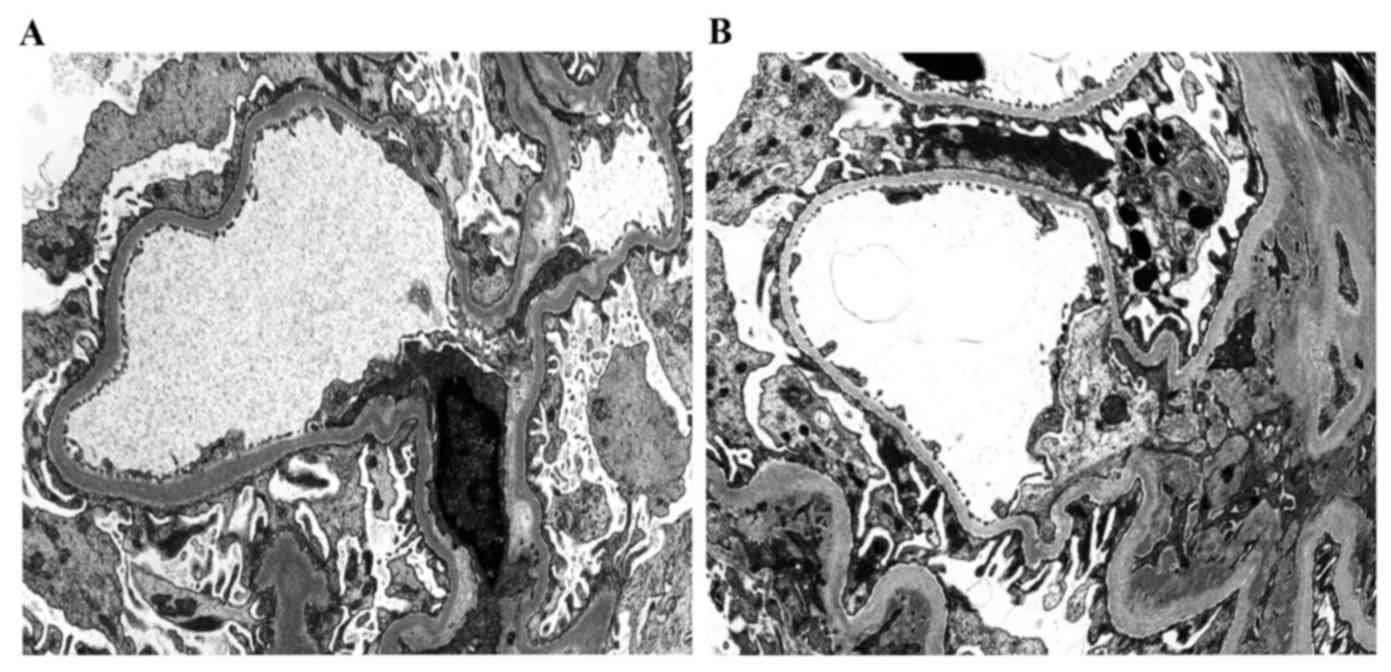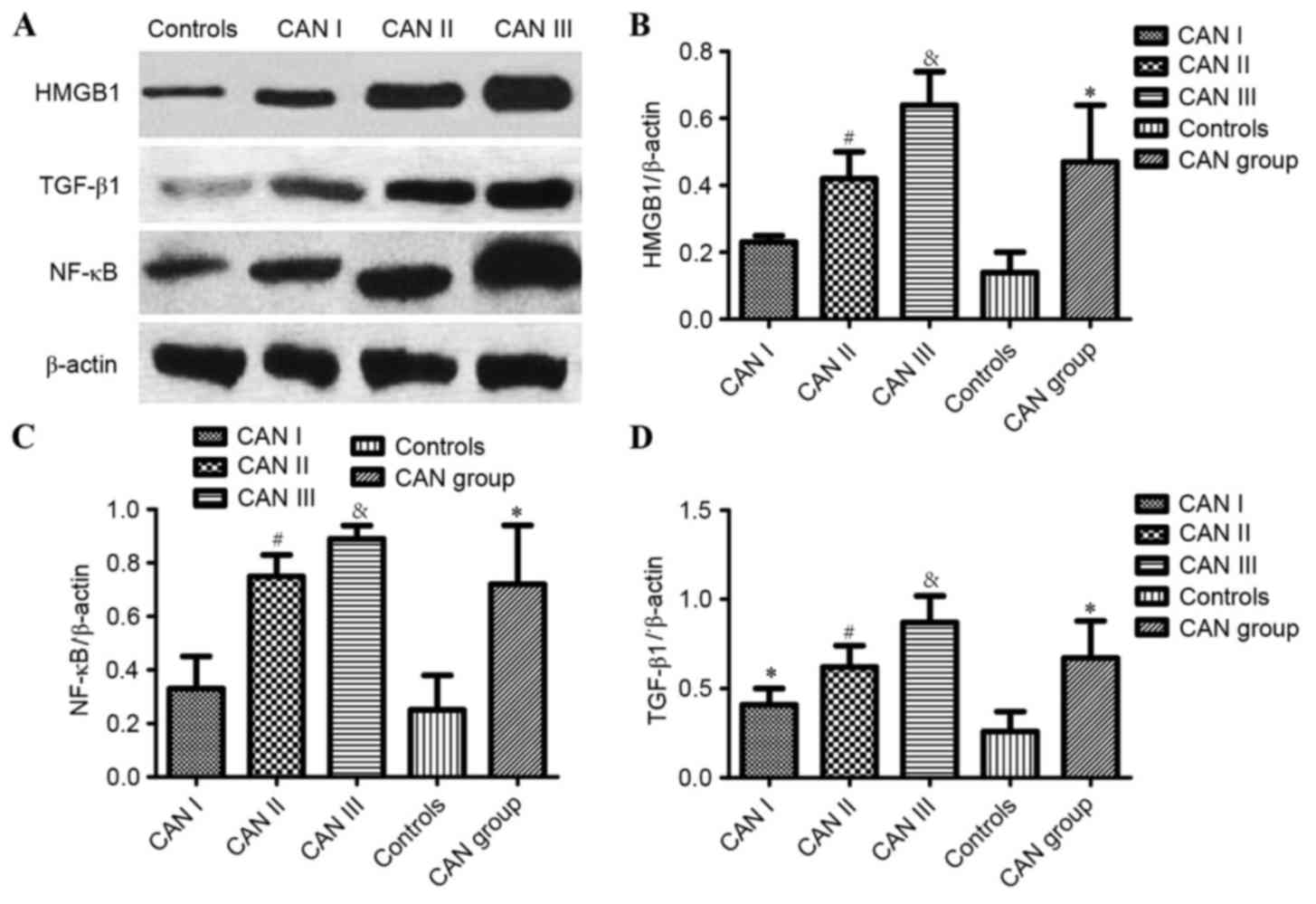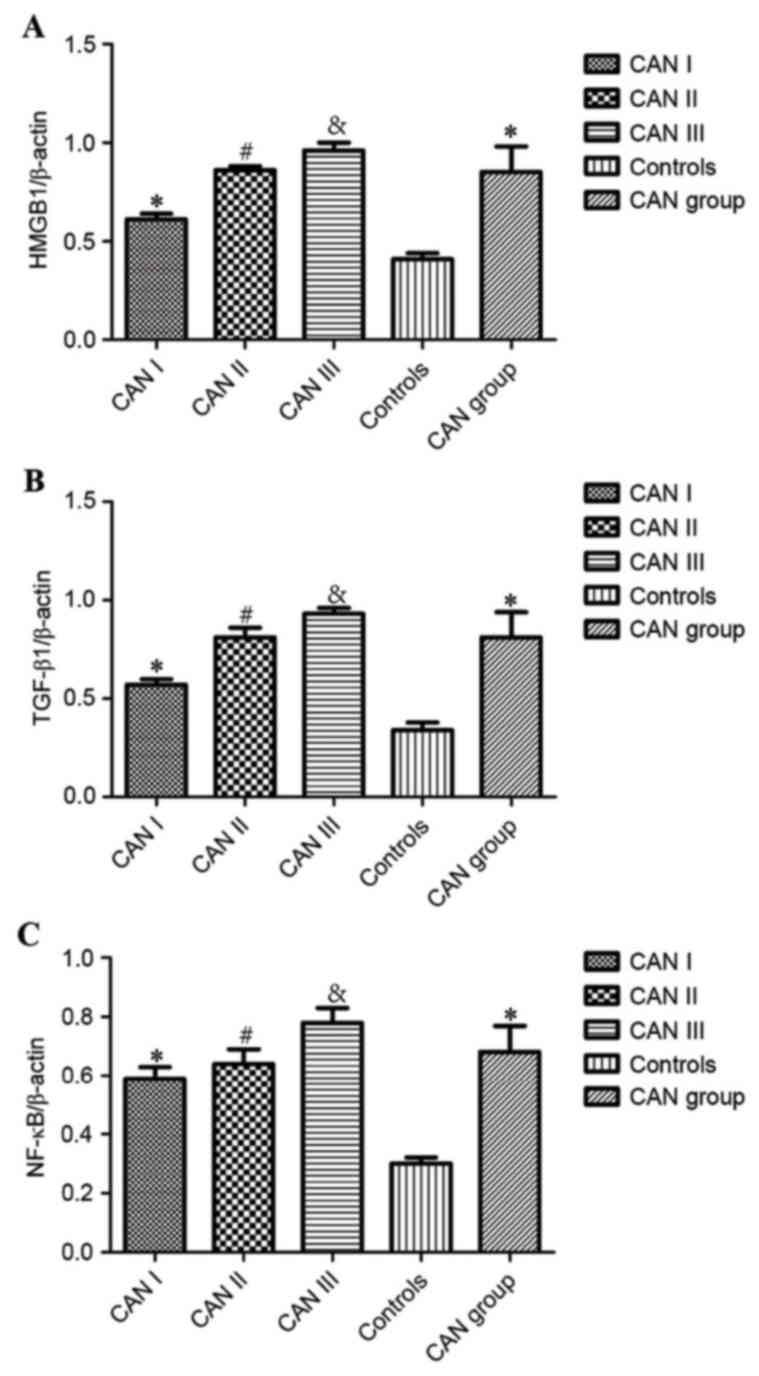|
1
|
Cui Y, Huang Q, Auman JT, Knight B, Jin X,
Blanchard KT, Chou J, Jayadev S and Paules RS: Genomic-derived
markers for early detection of calcineurin inhibitor
immunosuppressant-mediated nephrotoxicity. Toxicol Sci. 124:23–34.
2011. View Article : Google Scholar : PubMed/NCBI
|
|
2
|
Lamb KE, Lodhi S and Meier-Kriesche HU:
Long-term renal allograft survival in the United States: A critical
reappraisal. Am J Transplant. 11:450–462. 2011. View Article : Google Scholar : PubMed/NCBI
|
|
3
|
Cassidy H, Slyne J, O'Kelly P, Traynor C,
Conlon PJ, Johnston O, Slattery C, Ryan MP and McMorrow T: Urinary
biomarkers of chronic allograft nephropathy. Proteomics Clin Appl.
9:574–585. 2015. View Article : Google Scholar : PubMed/NCBI
|
|
4
|
Weir MR and Wali RK: Minimizing the risk
of chronic allograft nephropathy. Transplantation. 87 8
Suppl:S14–S18. 2009. View Article : Google Scholar : PubMed/NCBI
|
|
5
|
Birnbaum LM, Lipman M, Paraskevas S,
Chaudhury P, Tchervenkov J, Baran D, Herrera-Gayol A and
Cantarovich M: Management of chronic allograft nephropathy: A
systematic review. Clin J Am Soc Nephrol. 4:860–865. 2009.
View Article : Google Scholar : PubMed/NCBI
|
|
6
|
Lukenda V, Mikolasevic I, Racki S, Jelic
I, Stimac D and Orlic L: Transient elastography: A new noninvasive
diagnostic tool for assessment of chronic allograft nephropathy.
Int Urol Nephrol. 46:1435–1440. 2014. View Article : Google Scholar : PubMed/NCBI
|
|
7
|
Arndt R, Schmidt S, Loddenkemper C,
Grünbaum M, Zidek W, van der Giet M and Westhoff TH: Noninvasive
evaluation of renal allograft fibrosis by transient elastography-a
pilot study. Transpl Int. 23:871–877. 2010.PubMed/NCBI
|
|
8
|
Sayin B, Karakayali H, Colak T, Sevmis S,
Pehlivan S, Demirhan B and Haberal M: Conversion to sirolimus for
chronic allograft nephropathy and calcineurin inhibitor toxicity
and the adverse effects of sirolimus after conversion. Transplant
Proc. 41:2789–2793. 2009. View Article : Google Scholar : PubMed/NCBI
|
|
9
|
Haas M: Chronic allograft nephropathy or
interstitial fibrosis and tubular atrophy: What is in a name? Curr
Opin Nephrol Hypertens. 23:245–250. 2014. View Article : Google Scholar : PubMed/NCBI
|
|
10
|
Del Bello A, Rostaing L, Congy-Jolivet N,
Sallusto F, Gamé X and Kamar N: Kidney nephrectomy after allograft
failure. Nephrol Ther. 9:189–194. 2013.(In French). View Article : Google Scholar : PubMed/NCBI
|
|
11
|
Wang K and Liu QZ: Effect analysis of
1-year posttransplant body mass index on chronic allograft
nephropathy in renal recipients. Transplant Proc. 43:2592–2595.
2011. View Article : Google Scholar : PubMed/NCBI
|
|
12
|
Johnston O, Cassidy H, O'Connell S,
O'Riordan A, Gallagher W, Maguire PB, Wynne K, Cagney G, Ryan MP,
Conlon PJ and McMorrow T: Identification of β2-microglobulin as a
urinary biomarker for chronic allograft nephropathy using proteomic
methods. Proteomics Clin Appl. 5:422–431. 2011. View Article : Google Scholar : PubMed/NCBI
|
|
13
|
Zhu P, Xie L, Ding HS, Gong Q, Yang J and
Yang L: High mobility group box 1 and kidney diseases (Review). Int
J Mol Med. 31:763–768. 2013. View Article : Google Scholar : PubMed/NCBI
|
|
14
|
Srinivasan M, Banerjee S, Palmer A, Zheng
G, Chen A, Bosland MC, Kajdacsy-Balla A, Kalyanasundaram R and
Munirathinam G: HMGB1 in hormone-related cancer: A potential
therapeutic target. Horm Cancer. 5:127–139. 2014. View Article : Google Scholar : PubMed/NCBI
|
|
15
|
Kang R, Chen R, Zhang Q, Hou W, Wu S, Cao
L, Huang J, Yu Y, Fan XG, Yan Z, et al: HMGB1 in health and
disease. Mol Aspects Med. 40:1–116. 2014. View Article : Google Scholar : PubMed/NCBI
|
|
16
|
Li J, Gong Q, Zhong S, Wang L, Guo H,
Xiang Y, Ichim TE, Wang CY, Chen S, Gong F and Chen G:
Neutralization of the extracellular HMGB1 released by ischaemic
damaged renal cells protects against renal ischaemia-reperfusion
injury. Nephrol Dial Transplant. 26:469–478. 2011. View Article : Google Scholar : PubMed/NCBI
|
|
17
|
Bruchfeld A, Qureshi AR, Lindholm B,
Barany P, Yang L, Stenvinkel P and Tracey KJ: High Mobility Group
Box Protein-1 correlates with renal function in chronic kidney
disease (CKD). Mol Med. 14:109–115. 2008. View Article : Google Scholar : PubMed/NCBI
|
|
18
|
Leelahavanichkul A, Huang Y, Hu X, Zhou H,
Tsuji T, Chen R, Kopp JB, Schnermann J, Yuen PS and Star RA:
Chronic kidney disease worsens sepsis and sepsis-induced acute
kidney injury by releasing High Mobility Group Box Protein-1.
Kidney Int. 80:1198–1211. 2011. View Article : Google Scholar : PubMed/NCBI
|
|
19
|
Zakiyanov O, Kriha V, Vachek J, Zima T,
Tesar V and Kalousova M: Placental growth factor,
pregnancy-associated plasma protein-A, soluble receptor for
advanced glycation end products, extracellular newly identified
receptor for receptor for advanced glycation end products binding
protein and high mobility group box 1 levels in patients with acute
kidney injury: A cross sectional study. BMC Nephrol. 14:2452013.
View Article : Google Scholar : PubMed/NCBI
|
|
20
|
Oyama Y, Hashiguchi T, Taniguchi N,
Tancharoen S, Uchimura T, Biswas KK, Kawahara K, Nitanda T, Umekita
Y, Lotz M and Maruyama I: High-mobility group box-1 protein
promotes granulomatous nephritis in adenine-induced nephropathy.
Lab Invest. 90:853–866. 2010. View Article : Google Scholar : PubMed/NCBI
|
|
21
|
Bhatelia K, Singh K and Singh R: TLRs:
Linking inflammation and breast cancer. Cell Signal. 26:2350–2357.
2014. View Article : Google Scholar : PubMed/NCBI
|
|
22
|
Zhou TB: Role of high mobility group box 1
and its signaling pathways in renal diseases. J Recept Signal
Transduct Res. 34:348–350. 2014. View Article : Google Scholar : PubMed/NCBI
|
|
23
|
Pateras I, Giaginis C, Tsigris C,
Patsouris E and Theocharis S: NF-κB signaling at the crossroads of
inflammation and atherogenesis: Searching for new therapeutic
links. Expert Opin Ther Targets. 18:1089–1101. 2014. View Article : Google Scholar : PubMed/NCBI
|
|
24
|
Hayden MS and Ghosh S: Regulation of NF-κB
by TNF family cytokines. Semin Immunol. 26:253–266. 2014.
View Article : Google Scholar : PubMed/NCBI
|
|
25
|
Sanz AB, Sanchez-Niño MD, Ramos AM, Moreno
JA, Santamaria B, Ruiz-Ortega M, Egido J and Ortiz A: NF-kappaB in
renal inflammation. J Am Soc Nephrol. 21:1254–1262. 2010.
View Article : Google Scholar : PubMed/NCBI
|
|
26
|
Mohammed-Ali Z, Cruz GL and Dickhout JG:
Crosstalk between the unfolded protein response and NF-κB-mediated
inflammation in the progression of chronic kidney disease. J
Immunol Res. 2015:4285082015. View Article : Google Scholar : PubMed/NCBI
|
|
27
|
Harris S, Coupes BM, Roberts SA, Roberts
IS, Short CD and Brenchley PE: TGF-beta1 in chronic allograft
nephropathy following renal transplantation. J Nephrol. 20:177–185.
2007.PubMed/NCBI
|
|
28
|
Daniel C, Vogelbacher R, Stief A, Grigo C
and Hugo C: Long-term gene therapy with thrombospondin 2 inhibits
TGF-β activation, inflammation and angiogenesis in chronic
allograft nephropathy. PLoS One. 8:e838462013. View Article : Google Scholar : PubMed/NCBI
|
|
29
|
Ding Y and Choi ME: Regulation of
autophagy by TGF-β: Emerging role in kidney fibrosis. Semin
Nephrol. 34:62–71. 2014. View Article : Google Scholar : PubMed/NCBI
|
|
30
|
Choi ME, Ding Y and Kim SI: TGF-β
signaling via TAK1 pathway: Role in kidney fibrosis. Semin Nephrol.
32:244–252. 2012. View Article : Google Scholar : PubMed/NCBI
|
|
31
|
Li Y, Ge Y, Liu FY, Peng YM, Sun L, Li J,
Chen Q, Sun Y and Ye K: Norcantharidin, a protective therapeutic
agent in renal tubulointerstitial fibrosis. Mol Cell Biochem.
361:79–83. 2012. View Article : Google Scholar : PubMed/NCBI
|
|
32
|
Ka SM, Yeh YC, Huang XR, Chao TK, Hung YJ,
Yu CP, Lin TJ, Wu CC, Lan HY and Chen A: Kidney-targeting Smad7
gene transfer inhibits renal TGF-β/MAD homologue (SMAD) and nuclear
factor κB (NF-κB) signalling pathways and improves diabetic
nephropathy in mice. Diabetologia. 55:509–519. 2012. View Article : Google Scholar : PubMed/NCBI
|
|
33
|
Lan HY and Chung AC: TGF-β/Smad signaling
in kidney disease. Semin Nephrol. 32:236–243. 2012. View Article : Google Scholar : PubMed/NCBI
|
|
34
|
Srinivas TR and Oppenheimer F: Identifying
endpoints to predict the influence of immunosuppression on
long-term kidney graft survival. Clin Transplant. 29:644–653. 2015.
View Article : Google Scholar : PubMed/NCBI
|
|
35
|
Xia SQ, Fan Y, Tan MY and Zheng JH:
Five-year follow-up after conversion from calcineurin inhibitor to
sirolimus-based treatment in kidney transplant patients with
chronic allograft nephropathy. Int J Clin Exp Med. 8:3552–3558.
2015.PubMed/NCBI
|
|
36
|
Shrestha B and Haylor J: Experimental rat
models of chronic allograft nephropathy: A review. Int J Nephrol
Renovasc Dis. 7:315–322. 2014. View Article : Google Scholar : PubMed/NCBI
|
|
37
|
Timsit MO, Yuan X, Floerchinger B, Ge X
and Tullius SG: Consequences of transplant quality on chronic
allograft nephropathy. Kidney Int Suppl. S54–S58. 2010. View Article : Google Scholar : PubMed/NCBI
|
|
38
|
Leca N: Focal segmental glomerulosclerosis
recurrence in the renal allograft. Adv Chronic Kidney Dis.
21:448–452. 2014. View Article : Google Scholar : PubMed/NCBI
|
|
39
|
Liao QB, Guo JQ, Zheng XY, Zhou ZF, Li H,
Lai XY and Ye JF: Test performance of sputum microRNAs for lung
cancer: A meta-analysis. Genet Test Mol Biomarkers. 18:562–567.
2014. View Article : Google Scholar : PubMed/NCBI
|
|
40
|
Schinstock CA, Stegall M and Cosio F: New
insights regarding chronic antibody-mediated rejection and its
progression to transplant glomerulopathy. Curr Opin Nephrol
Hypertens. 23:611–618. 2014. View Article : Google Scholar : PubMed/NCBI
|
|
41
|
Tan Y, Wang Q, She Y, Bi X and Zhao B:
Ketamine reduces LPS-induced HMGB1 via activation of the Nrf2/HO-1
pathway and NF-κB suppression. J Trauma Acute Care Surg.
78:784–792. 2015. View Article : Google Scholar : PubMed/NCBI
|
|
42
|
Shi Z, Lian A and Zhang F: Nuclear
factor-κB activation inhibitor attenuates ischemia reperfusion
injury and inhibits Hmgb1 expression. Inflamm Res. 63:919–925.
2014. View Article : Google Scholar : PubMed/NCBI
|
|
43
|
Zhou XJ, Dong ZG, Yang YM, Du LT, Zhang X
and Wang CX: Limited diagnostic value of microRNAs for detecting
colorectal cancer: A meta-analysis. Asian Pac J Cancer Prev.
14:4699–4704. 2013. View Article : Google Scholar : PubMed/NCBI
|
|
44
|
Terhzaz S, Overend G, Sebastian S, Dow JA
and Davies SA: The D. Melanogaster capa-1 neuropeptide activates
renal NF-kB signaling. Peptides. 53:218–224. 2014. View Article : Google Scholar : PubMed/NCBI
|
|
45
|
Kim HJ, Kim JG, Moon MY, Park SH and Park
JB: IκB kinase γ/nuclear factor-κB-essential modulator (IKKγ/NEMO)
facilitates RhoA GTPase activation, which, in turn, activates
Rho-associated KINASE (ROCK) to phosphorylate IKKβ in response to
transforming growth factor (TGF)-β1. J Biol Chem. 289:1429–1440.
2014. View Article : Google Scholar : PubMed/NCBI
|
|
46
|
Jia QQ, Wang JC, Long J, Zhao Y, Chen SJ,
Zhai JD, Wei LB, Zhang Q, Chen Y and Long HB: Sesquiterpene
lactones and their derivatives inhibit high glucose-induced NF-κB
activation and MCP-1 and TGF-β1 expression in rat mesangial cells.
Molecules. 18:13061–13077. 2013. View Article : Google Scholar : PubMed/NCBI
|
|
47
|
Oo YH, Shetty S and Adams DH: The role of
chemokines in the recruitment of lymphocytes to the liver. Dig Dis.
28:31–44. 2010. View Article : Google Scholar : PubMed/NCBI
|
|
48
|
Saigo K, Akutsu N, Maruyama M, Otsuki K,
Hasegawa M, Aoyama H, Matsumoto I, Asano T and Kenmochi T: Study of
transforming growth factor-β1 gene, mRNA, and protein in Japanese
renal transplant recipients. Transplant Proc. 46:372–375. 2014.
View Article : Google Scholar : PubMed/NCBI
|
|
49
|
Assadiasl S, Ahmadpoor P, Nafar M,
Pezeshki Lessan M, Pourrezagholi F, Parvin M, Shahlaee A, Sepanjnia
A, Nicknam MH and Amirzargar A: Regulatory T cell subtypes and
TGF-β1 gene expression in chronic allograft dysfunction. Iran J
Immunol. 11:139–152. 2014.PubMed/NCBI
|
|
50
|
Liu H, Sun W, Wan YG, Tu Y, Yu BY and Hu
H: Regulatory mechanism of NF-kappaB signaling pathway on renal
tissue inflammation in chronic kidney disease and interventional
effect of traditional Chinese medicine. Zhongguo Zhong Yao Za Zhi.
38:4246–4251. 2013.(In Chinese). PubMed/NCBI
|
|
51
|
Braz MM, Ramalho FS, Cardoso RL, Zucoloto
S, Costa RS and Ramalho LN: Slight activation of nuclear factor
kappa-B is associated with increased hepatic stellate cell
apoptosis in human schistosomal fibrosis. Acta Trop. 113:66–71.
2010. View Article : Google Scholar : PubMed/NCBI
|
|
52
|
Guicciardi ME and Gores GJ: Apoptosis as a
mechanism for liver disease progression. Semin Liver Dis.
30:402–410. 2010. View Article : Google Scholar : PubMed/NCBI
|
|
53
|
Qin L and Han YP: Epigenetic repression of
matrix metalloproteinases in myofibroblastic hepatic stellate cells
through histone deacetylases 4: Implication in tissue fibrosis. Am
J Pathol. 177:1915–1928. 2010. View Article : Google Scholar : PubMed/NCBI
|
|
54
|
Liu GQ, Zuo XH, Jiang LN, Zhang YP, Zhang
LM, Zhao ZG and Niu CY: Inhibitory effect of post-hemorrhagic shock
mesenteric lymph drainage on the HMGB1 and RAGE in mouse kidney.
Ren Fail. 38:131–136. 2016. View Article : Google Scholar : PubMed/NCBI
|
|
55
|
Qie GQ, Wang CT, Chu YF and Wang R:
Expression of HMGB1/RAGE protein in renal carcinoma and its
clinical significance. Int J Clin Exp Pathol. 8:6262–6268.
2015.PubMed/NCBI
|
|
56
|
Karuppagounder V, Arumugam S,
Thandavarayan RA, Pitchaimani V, Sreedhar R, Afrin R, Harima M,
Suzuki H, Nomoto M, Miyashita S, et al: Modulation of HMGB1
translocation and RAGE/NFκB cascade by quercetin treatment
mitigates atopic dermatitis in NC/Nga transgenic mice. Exp
Dermatol. 24:418–423. 2015. View Article : Google Scholar : PubMed/NCBI
|
|
57
|
Kang N, Hai Y, Yang J, Liang F and Gao CJ:
Hyperbaric oxygen intervention reduces secondary spinal cord injury
in rats via regulation of HMGB1/TLR4/NF-κB signaling pathway. Int J
Clin Exp Pathol. 8:1141–1153. 2015.PubMed/NCBI
|
|
58
|
Sun J, Shi S, Wang Q, Yu K and Wang R:
Continuous hemodiafiltration therapy reduces damage of multi-organs
by ameliorating of HMGB1/TLR4/NFκB in a dog sepsis model. Int J
Clin Exp Pathol. 8:1555–1564. 2015.PubMed/NCBI
|














